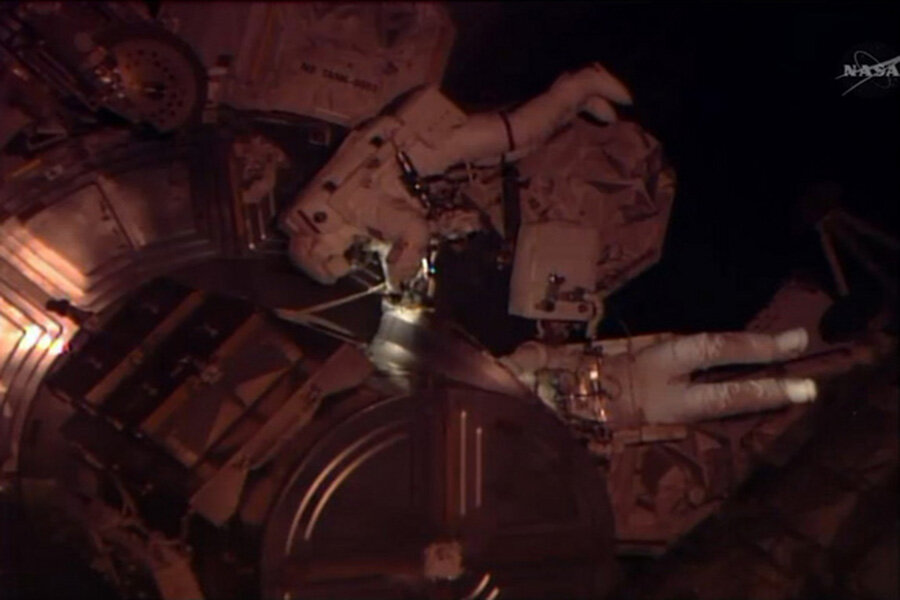Space station astronauts step outside to replace dead computer
A pair of NASA astronauts replaced a dead backup computer on the International Space Station during a short spacewalk Wednesday (April 23) to restore a critical computer system back to full strength.
NASA astronauts Rick Mastracchio and Steve Swanson made quick work of their repair during the spacewalk, removing the faulty station computer and installing a spare less than an hour after floating outside the orbiting laboratory at 9:56 a.m. EDT (1356 GMT).
"It looks like a good day for you guys to take a walk in space," Mission Control radioed the astronauts as the spacewalk began. The spacewalk was slated to last only 2.5 hours. [See photos from today's spacewalk]
Mastracchio and Swanson replaced a computer known in NASA parlance as a Multiplexer-Demultiplexer, or MDM. The device is a backup computer for routing commands to systems supporting the space station's solar arrays, robotic arm rail car and other critical systems along the station's backbone-like main truss.
The 10-year-old MDM computer failed on April 11 during a standard test. The primary computer in the system is working fine, but NASA station flight controllers ordered today's repair spacewalk to restore redundancy in the system.
"Looks like we've got a new MDM," Mastracchio said as he finished the job.
A quick test showed the new computer was working fine.
"Oh wonderful," Mastracchio said.
There are 45 MDM computers on the International Space Station, with 21 of them located on the orbiting lab's exterior and the rest installed inside the station's habitable area. Replacing the MDM computer boxes is one of 12 core space station repair skills astronauts learn before launch, NASA officials have said.
Despite their swift work, the spacewalkers did take time to marvel at the bright blue Earth below. At one point, Mastracchio reminded Swanson to take a look down at the sunlit Earth.
"Where are we?" Mastracchio asked Mission Control later. The answer: Over South America.
"A great view," the astronaut replied.
Wednesday's 2.5-hour spacewalk was substantially shorter than the typical six-hour excursions astronauts take outside the International Space Station. That's because the MDM computer replacement was sole goal for Mastracchio and Swanson
"We want to get this job done as quickly as we can, so we didn't want to add a whole bunch of things for this team to sort out," NASA space station program manager Mike Suffredini told reporters on Friday (April 18).
Suffredini said the decision for a short spacewalk is also a safety measure for Mastracchio and Swanson, who are using spacesuits that have new water filters and fan pump systems. That maintenance was performed in the wake of a harrowing June 2013 spacewalk in which a water leak flooded the helmet of Italian astronaut Luca Parmitano, nearly drowning him. NASA engineers suspect contamination in the water line caused the leak.
"I feel pretty strongly that we've sorted out the root cause and that our suits are in good shape," Suffredini said.
Today's space station repairs marked the ninth career spacewalk for Mastracchio, and the fifth spacewalk for Swanson. Japanese astronaut Koichi Wakata and Russian cosmonauts Mikhail Tyurin, Oleg Artemyev and Alexander Skvortsov round out the crew. The spacewalk came on the heels of two other major events for the six-man crew on the International Space Station.
On Sunday (April 20), an unmanned SpaceX Dragon cargo ship arrived at the station carrying 2.5 tons of fresh supplies and gear for the orbiting lab's crew. Then earlier today, at 4:58 a.m. EDT (0858 GMT), a robotic Russian Progress 53 cargo ship was due to undock from the station and park itself about 311 miles (500 kilometers) from the orbiting lab to test its new Kurs automated docking system. The Progress spacecraft is due to return to the space station on Friday (April 25).
Editor's Note: This story was updated at 10:57 a.m. ET to reflect the successful replacement of the faulty space station computer.
Email Tariq Malik at tmalik@space.com or follow him @tariqjmalik and Google+. Follow us @Spacedotcom, Facebook and Google+. Original article on Space.com.
- Cosmic Quiz: Do You Know the International Space Station?
- Space Station Photos: Expedition 39 Mission Crew in Orbit
- Inside Space Station - The Video Show
Copyright 2014 SPACE.com, a TechMediaNetwork company. All rights reserved. This material may not be published, broadcast, rewritten or redistributed.






